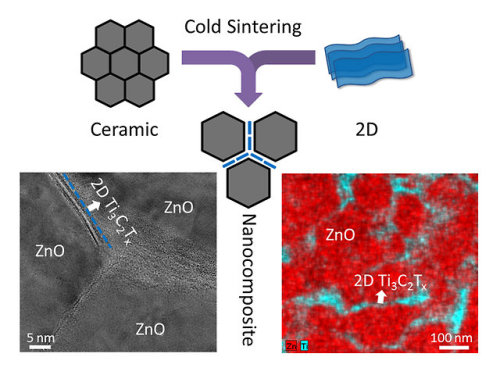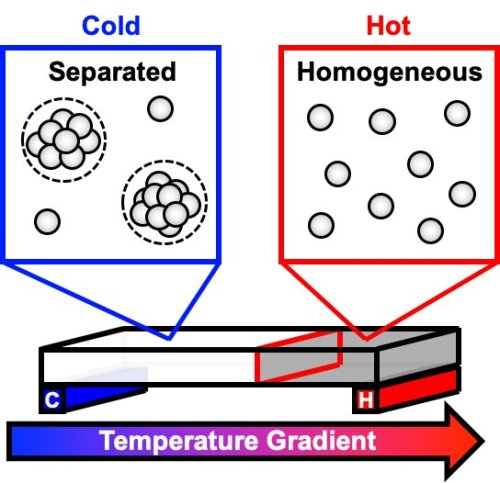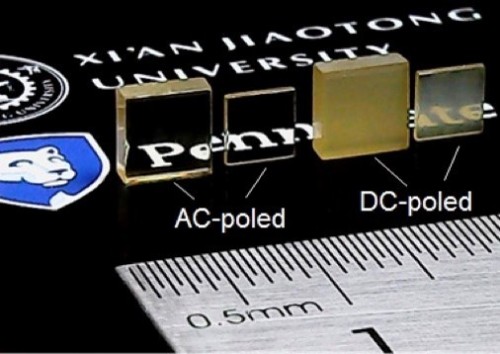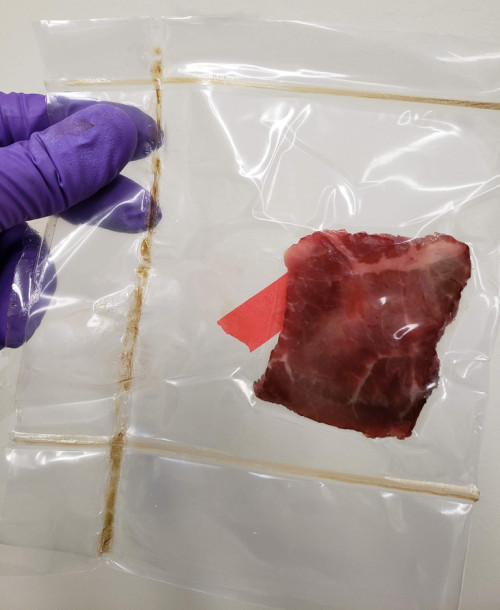#penn state
Sintering atomically thin materials with ceramics now possible
For the first time, researchers have created a nanocomposite of ceramics and a two-dimensional material, opening the door for new designs of nanocomposites with such applications as solid-state batteries, thermoelectrics, varistors, catalysts, chemical sensors and much more.
Sintering uses high heat to compact powder materials into a solid form. Widely used in industry, ceramic powders are typically compacted at temperatures of 1472 degrees Fahrenheit or higher. Many low-dimensional materials cannot survive at those temperatures.
But a sintering process developed by a team of researchers at Penn State, called the cold sintering process (CSP), can sinter ceramics at much lower temperatures, less than 572 degrees F, saving energy and enabling a new form of material with high commercial potential.
“We have industry people who are already very interested in this work,” said Jing Guo, a post-doctoral scholar working in the group of Clive Randall, professor of materials science and engineering, Penn State. “They are interested in developing some new material applications with this system and, in general, using CSP to sinter nanocomposites.” Guo is first coauthor on the paper appearing online in Advanced Materials.
Post link
Engineers develop new software tool to aid material modeling research
A new software tool can accelerate materials science research by cutting out tedious background research on material properties. Penn State and Sandia National Laboratories researchers recently debuted propSym, an open-source software on the programming platform MATLAB, to calculate the fundamental constants needed to describe the physical properties of solids, such as metals, ceramics or composites.
Researchers input a material’s physical characteristics and structure, and the program produces its fundamental property constants—key values researchers need to model various materials.
“Some physical models contain hundreds or thousands of redundant components, which can make the model overwhelming,” said Anubhav Roy, a doctoral student in engineering science and mechanics in the Penn State College of Engineering and first author on the paper. “The program is able to greatly reduce the number of components for any physical property that is connected to solids with inherent crystalline symmetry.”
Post link
New piezoelectric material remains effective to high temperatures
Piezoelectric materials hold great promise as sensors and as energy harvesters but are normally much less effective at high temperatures, limiting their use in environments such as engines or space exploration. However, a new piezoelectric device developed by a team of researchers from Penn State and QorTek remains highly effective at elevated temperatures.
Clive Randall, director of Penn State’s Materials Research Institute (MRI), developed the material and device in partnership with researchers from QorTek, a State College, Pennsylvania-based company specializing in smart material devices and high-density power electronics.
“NASA’s need was how to power electronics in remote locations where batteries are difficult to access for changing,” Randall said. “They also wanted self-powering sensors that monitor systems such as engine stabilities and have these devices work during rocket launches and other high-temperature situations where current piezoelectrics fail due to the heat.”
Post link
New model describes phase separation that spoils antibody solutions
A new mathematical model describes how highly concentrated antibody solutions separate into different phases, similar to an oil and water mixture. This separation can reduce the stability and shelf-life of some drugs that use monoclonal antibodies, including some used to treat autoimmune diseases and cancer. A team of scientists from Penn State and MedImmune, LLC (now AstraZeneca) investigated the thermodynamics and kinetics, the relationships between temperature, energy, and the rates of chemical reactions, of the phenomenon using an innovative method that allows for the rapid study of multiple samples at once. A paper describing their model appears July 22, 2019, in the journal Proceedings of the National Academy of Sciences.
Many drugs today are stored as solids and dissolved in IV bags for delivery to patients, but the pharmaceutical industry has been moving toward drugs that can be stored as liquids and given via a shot. Some of these drug solutions, like those used to treat autoimmune diseases and some cancers, contain high concentrations of monoclonal antibodies—proteins that attach to foreign substances in the body, like bacteria and viruses, flagging them for destruction by the patient’s immune system.
Post link
Two Layers Are Better Than One for Efficient Solar Cells – Affordable, Thin Film Solar Cells With 34% Efficiency
Solar cells have come a long way, but inexpensive, thin film solar cells are still far behind more expensive, crystalline solar cells in efficiency. Now, a team of researchers suggests that using two thin films of different materials may be the way to go to create affordable, thin film cells with about 34% efficiency.
“Ten years ago I knew very little about solar cells, but it became clear to me they were very important,” said Akhlesh Lakhtakia, Evan Pugh University Professor and Charles Godfrey Binder Professor of Engineering Science and Mechanics, Penn State.
Investigating the field, he found that researchers approached solar cells from two sides, the optical side — looking on how the sun’s light is collected — and the electrical side — looking at how the collected sunlight is converted into electricity. Optical researchers strive to optimize light capture, while electrical researchers strive to optimize conversion to electricity, both sides simplifying the other.
“I decided to create a model in which both electrical and optical aspects will be treated equally,” said Lakhtakia. “We needed to increase actual efficiency, because if the efficiency of a cell is less than 30% it isn’t going to make a difference.” The researchers report their results in a recent issue of Applied Physics Letters.
Post link
Be part of an important study on the genetics of sexual orientation
· Have you had your DNA analyzed by 23andMe or Ancestry?
· Are you 18 years or older?
If you answered YES to these questions, you are eligible to participate in a study on sexual orientation.
The purpose of this research study is to understand how genetics may influence people’s personalities and sexual orientation. If you take part in this online study, we will instruct you how to find your genetic data file on your 23andMe account and upload it to our secure website. We will also ask you to complete a series of questionnaires on your personality and sexual behavior.
Time required to complete the study should be about 15-25 minutes.
Anyone 18 years or older who has been sexually active and has had a 23andMe or Ancestry analysis is eligible to participate, regardless of sexual orientation.
Please follow this link to begin the study:
https://pennstate.qualtrics.com/SE/?SID=SV_e5Vi2kF7dFeGGr3
This study is being conducted by the Department of Anthropology at Penn State University, 409 Carpenter Building, University Park, PA.
Please contact the study coordinator Heather Self ([email protected]) or the principal investigator David Puts ([email protected]) for further information.
Be part of an important study on the genetics of sexual orientation
· Have you had your DNA analyzed by 23andMe or Ancestry?
· Are you 18 years or older?
If you answered YES to these questions, you are eligible to participate in a study on sexual orientation.
The purpose of this research study is to understand how genetics may influence people’s personalities and sexual orientation. If you take part in this online study, we will instruct you how to find your genetic data file on your 23andMe account and upload it to our secure website. We will also ask you to complete a series of questionnaires on your personality and sexual behavior.
Time required to complete the study should be about 15-25 minutes.
Anyone 18 years or older who has been sexually active and has had a 23andMe or Ancestry analysis is eligible to participate, regardless of sexual orientation.
Please follow this link to begin the study:
https://pennstate.qualtrics.com/SE/?SID=SV_e5Vi2kF7dFeGGr3
This study is being conducted by the Department of Anthropology at Penn State University, 409 Carpenter Building, University Park, PA.
Please contact the study coordinator Heather Self ([email protected]) or the principal investigator David Puts ([email protected]) for further information.
Be part of an important study on the genetics of sexual orientation
· Have you had your DNA analyzed by 23andMe or Ancestry?
· Are you 18 years or older?
If you answered YES to these questions, you are eligible to participate in a study on sexual orientation.
The purpose of this research study is to understand how genetics may influence people’s personalities and sexual orientation. If you take part in this online study, we will instruct you how to find your genetic data file on your 23andMe account and upload it to our secure website. We will also ask you to complete a series of questionnaires on your personality and sexual behavior.
Time required to complete the study should be about 15-25 minutes.
Anyone 18 years or older who has been sexually active and has had a 23andMe or Ancestry analysis is eligible to participate, regardless of sexual orientation.
Please follow this link to begin the study:
https://pennstate.qualtrics.com/SE/?SID=SV_e5Vi2kF7dFeGGr3
This study is being conducted by the Department of Anthropology at Penn State University, 409 Carpenter Building, University Park, PA.
Please contact the study coordinator Heather Self ([email protected]) or the principal investigator David Puts ([email protected]) for further information.
Thefirst rankings from the College Football Playoff committee were released Tuesday evening with some surprises among the top four teams.
At the top are two unbeaten SEC teams in Georgia and Alabama. The Bulldogs and Crimson Tide are in opposite order in major polls. However, committee chairman Kirby Hocutt noted Georgia’s wins against No. 3 Notre Dame and No. 16 Mississippi State as the reason for putting Kirby Smart’s team ahead of the Alabama, which has no wins among teams in the top 25 in the rankings.
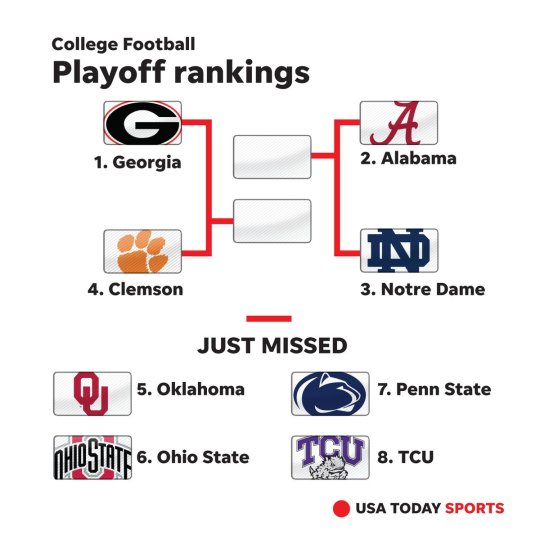
A weekend filled with high-profile matchups produced plenty of changes in the Amway Coaches Poll, though once again, the top-ranked team is as it has been all season. Alabama, which had the weekend off, is still the unanimous No. 1.
After that, the shuffling begins. Georgia climbs to No. 2 after dispatching archrival Florida. The Bulldogs appear to be on a collision course with the Crimson Tide in a month for the SEC title. Ohio State, the big winner of the weekend thanks to its comeback win against Penn State, vaults from sixth to No. 3 ahead of Wisconsin. Clemson, which got back on track with a win against Georgia Tech, is back in the top five.
After the crazy results from the previous college football weekend, Week 8 proved comparatively tame. As a result, the Amway Coaches Poll reflects few changes, with the same 25 teams still ranked. The order shifts a bit in places, but not around the top as the first six teams stay put.
Alabama is still the unanimous choice for No. 1 after a workmanlike smothering of struggling Tennessee. Penn State solidified its hold on the second position with a convincing triumph over Michigan. Georgia, which had the weekend off, holds steady at No. 3 with unbeatens TCU and Wisconsin rounding out the top five.
Ohio State, which hosts Penn State next week, remains No. 6. In a minor change, idle Clemson edges ahead of Miami (Fla.) for the No. 7 spot.
There’s at least one week like this every college football season, when a seemingly innocuous slate of games produces a slew of surprises.
Top-ranked Alabama, however, was not among the Week 7 upset victims. The Crimson Tide dispatched Arkansas and are now the unanimous No. 1 team in the Amway Coaches Poll.
The rest of the top five looks considerably different. Penn State, which picked a good week to have a bye, moves up to the No. 2 spot in the wake of Clemson’s loss to Syracuse. The Tigers tumbled to No. 8 as a result. Georgia, which got an early challenge before putting away Missouri, climbs to No. 3. TCU, the last unbeaten Big 12 squad, vaulted into the No. 4 spot ahead of No. 5 Wisconsin.
The Week 5 results produced little movement in the Amway Coaches Poll as the top teams for the most part held serve.
Alabama easily retains the No. 1 ranking after a 66-3 demolition of Mississippi. The Crimson Tide, who have outscored their first two SEC opponents by a combined margin of 125-3, received 59 of 65 first-place votes.
Clemson, a road winner at then-No. 12 Virginia Tech, stays put at No. 2 with the remaining six first-place nods. No. 3 Oklahoma, which had the weekend off, and fourth-ranked Penn State, an easy winner against Indiana, also maintain their positions. Washington, now the highest ranked Pac-12 member, climbs a notch into the top five.
Using straightforward chemistry and a mix-and-match, modular strategy, researchers have developed a simple approach that could produce over 65,000 different types of complex nanoparticles, each containing up to six different materials and eight segments, with interfaces that could be exploited in electrical or optical applications. These rod-shaped nanoparticles are about 55 nanometers long and 20 nanometers wide — by comparison a human hair is about 100,000 nanometers thick — and many are considered to be among the most complex ever made.
Learn more at Penn State News.
Post link
Transparency discovered in crystals with ultrahigh piezoelectricity
Use of an AC rather than a DC electric field can improve the piezoelectric response of a crystal. Now, an international team of researchers say that cycles of AC fields also make the internal crystal domains in some materials bigger and the crystal transparent.
“There have been reports that the use of AC fields could significantly improve the piezoelectric responses — for example by 20% to 40% — over DC fields and the improvements have always been attributed to the smaller internal ferroelectric domain sizes that resulted from the cycles of AC fields,” said Long-Qing Chen, Hamer Professor of Materials Science and Engineering, professor of engineering science and mechanics, and professor of mathematics at Penn State. “About three years ago, Dr. Fei Li, then a research associate at the Materials Research Institute at Penn State, largely confirmed the improvement of piezoelectric performances from application of AC fields. However, it was not clear at all how the internal ferroelectric domains evolved during AC cycles.
According to researchers, the work “presents a paradigm to achieve an unprecedented combination of properties and functionalities through ferroelectric domain engineering, and the new transparent ferroelectric crystals reported here are expected to open up a wide range of hybrid device applications, such as medical imaging, self-energy-harvesting touch screens and invisible robotic devices.”
Learn more about this research at Penn State News!
Post link

IMAGE: © iStock Photo / royaltystockphoto
An industrial chemical — phased out since 2002, but previously used in stain and water-repellent products and firefighting foam — alters the gut microbiome of mice and could have implications for human health, according to an international team of researchers.
Perfluorooctane sulfonate, or PFOS, persists in the environment and in the bodies of living organisms. While the U.S. Environmental Protection Agency designated PFOS a “contaminant of emerging concern” and its production was voluntarily ceased in the United States by producers, it is still detected in the blood of up to 99% of the U.S. population.
“We know that chronic exposure to some environmental chemicals, including persistent organic pollutants, can impact the gut microbiome, and we are actively assessing whether these interactions can impact health,” said Andrew Patterson, Tombros Early Career Professor and professor of molecular toxicology, Penn State. “Our study shows that PFOS alters the composition and function of the microbiome, which suggests that this chemical and perhaps related chemicals, have mechanisms of action outside our own cells. Exploring how chemicals impact the microbiome is an important and emerging area of study.”
Read more about this work at Penn State News!
Novel composite antimicrobial film could take a bite out of foodborne illnesses
A novel composite film — created by the bonding of an antimicrobial layer to conventional, clear polyethylene plastic typically used to vacuum-package foods such as meat and fish — could help to decrease foodborne illness outbreaks, according to researchers in Penn State’s College of Agricultural Sciences.
Raw beef (shown here), raw chicken breast and ready-to-eat turkey breast were inoculated with pathogens then vacuum packaged with the composite antimicrobial film, sealed and placed into refrigerated storage. The composite antimicrobial film significantly reduced foodborne pathogens on the experimentally inoculated surfaces of the raw and ready-to-eat muscle foods.

The novel composite antimicrobial film stopped pathogens from growing on this ready-to-eat turkey breast.
Learn more at Penn State News.
Post link
Researchers have discovered that neonicotinoid seed treatments are driving a dramatic increase in insecticide toxicity in U.S. agricultural landscapes, despite evidence that these treatments have little to no benefit in many crops.
During the past 20 years, insecticides applied to U.S. agricultural landscapes have become significantly more toxic — over 120-fold in some midwestern states — to honey bees when ingested, according to a team of researchers, who identified rising neonicotinoid seed treatments in corn and soy as the primary driver of this change. The study is the first to characterize the geographic patterns of insecticide toxicity to bees and reveal specific areas of the country where mitigation and conservation efforts could be focused.
According to Christina Grozinger, Distinguished Professor of Entomology and director of the Center for Pollinator Research, Penn State, this toxicity has increased during the same period in which widespread decline in populations of pollinators and other insects have been documented.
“Insecticides are important for managing insects that damage crops, but they can also affect other insect species, such as bees and other pollinators, in the surrounding landscape,” she said. “It is problematic that there is such a dramatic increase in the total insecticide toxicity at a time when there is also so much concern about declines in populations of pollinating insects, which also play a very critical role in agricultural production.”
You can read more about this work at Penn State News!
Post link

